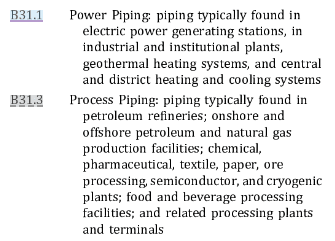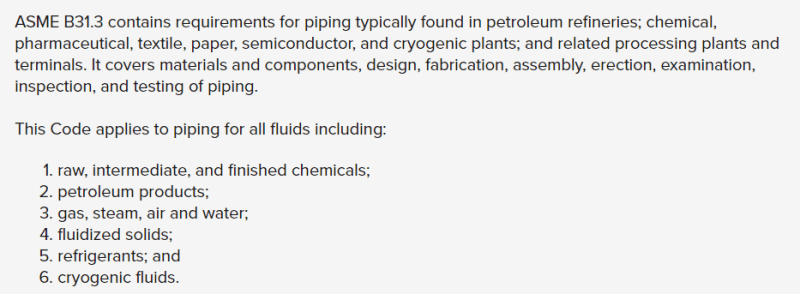I'm the engineer on multiple water loops in my company's test lab. I've recently started getting requests for testing of hotter water than I have in the past, up to 250F and beyond. Does this mean that my test facility piping needs to fall in line with ASME B31.1? I'm confused by the scope of B31.1 because 100.1.2 indicates the code covers high-temperature water at pressures exceeding 160 psig and/or temperatures exceeding 250F. However, 100.1.3 indicates that hot water heating systems designed for 30 psig or less are out of scope, which seems to imply that above 30 psig is in scope. This contradicts what was stated in 100.1.2. So what code do I need to abide by if I'm greater than 30 psig, but less than 160 psig and 250F?
Navigation
Install the app
How to install the app on iOS
Follow along with the video below to see how to install our site as a web app on your home screen.
Note: This feature may not be available in some browsers.
More options
Style variation
-
Congratulations TugboatEng on being selected by the Eng-Tips community for having the most helpful posts in the forums last week. Way to Go!
You are using an out of date browser. It may not display this or other websites correctly.
You should upgrade or use an alternative browser.
You should upgrade or use an alternative browser.
Piping design of hot water systems
- Thread starter AndrewBF
- Start date
- Status
- Not open for further replies.
Depends on the use of the system, not specifically any temperature or pressure.
31.1 is power as in boilers for electrical or mechanical power gen.
31.3 usually involves chemical processing of one sort or another.
B31.5 is Heat Transfer and Refridgeration.
Einstein gave the same test to students every year. When asked why he would do something like that, "Because the answers had changed."
31.1 is power as in boilers for electrical or mechanical power gen.
31.3 usually involves chemical processing of one sort or another.
B31.5 is Heat Transfer and Refridgeration.
Einstein gave the same test to students every year. When asked why he would do something like that, "Because the answers had changed."
- Thread starter
- #3
- Thread starter
- #5
Actually no of course not. And I never cracked the cover on 5, but I think I've heard of late that supposedly a better fluid for heat pumps is butane, although water is the subject here.
Einstein gave the same test to students every year. When asked why he would do something like that, "Because the answers had changed."
Einstein gave the same test to students every year. When asked why he would do something like that, "Because the answers had changed."
LittleInch
Petroleum
Try googling hot water design code / standard in your are and see what it brings up.
B31.1 is a bit of a mighty beast to unleash on what is still essentially a hot water system.
I know this is UK / Europe but I found this Look at the codes section
Is there an industry association for your specific item?
As superheated water you definitely need to start doing things properly and looking at safety and risk, but B31.1 really is designed for large power plants and steam boilers
Remember - More details = better answers
Also: If you get a response it's polite to respond to it.
B31.1 is a bit of a mighty beast to unleash on what is still essentially a hot water system.
I know this is UK / Europe but I found this Look at the codes section
Is there an industry association for your specific item?
As superheated water you definitely need to start doing things properly and looking at safety and risk, but B31.1 really is designed for large power plants and steam boilers
Remember - More details = better answers
Also: If you get a response it's polite to respond to it.
- Status
- Not open for further replies.
Similar threads
- Question
- Replies
- 2
- Views
- 2K
- Replies
- 7
- Views
- 5K
- Question
- Replies
- 10
- Views
- 9K
- Question
- Replies
- 5
- Views
- 3K
- Replies
- 9
- Views
- 4K


